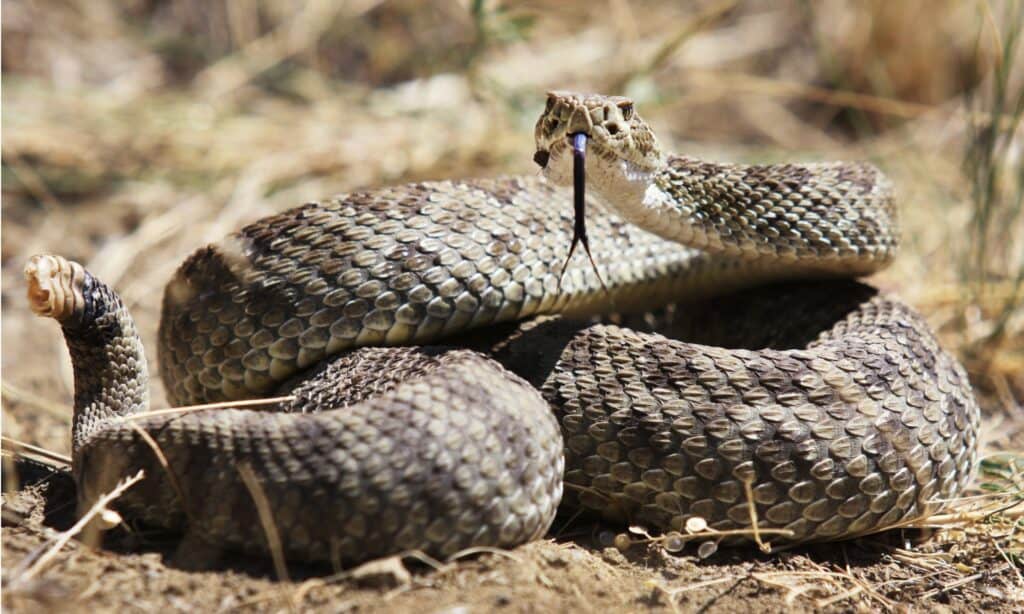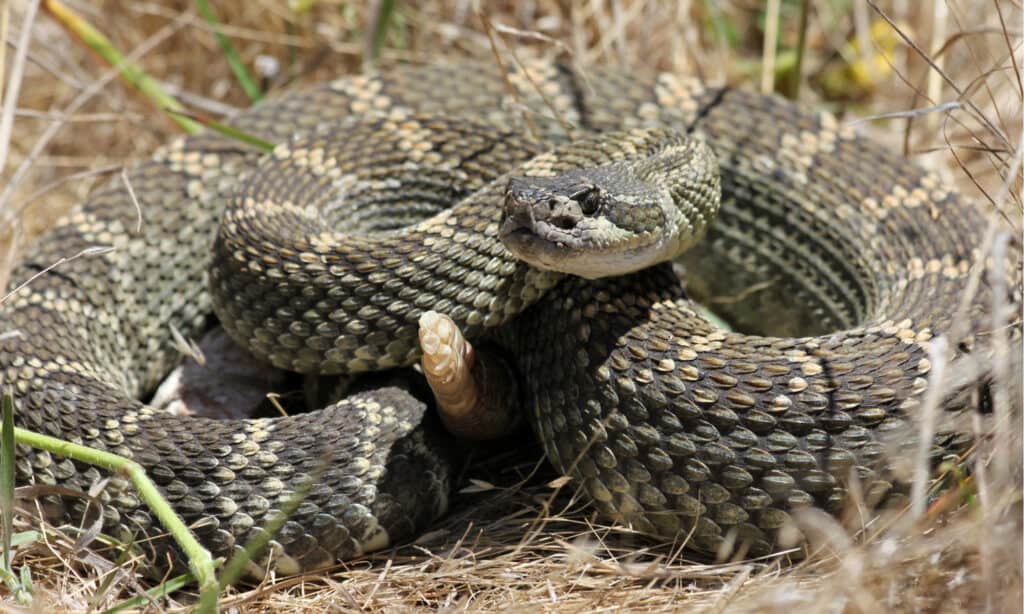Situated along the border of the United States and Canada, Idaho has a rugged landscape, filled with untamed natural environments. The state is an ideal home for many species of wildlife, but surprisingly, there are not as many snakes here as you might expect. In fact, there are only 12 species of snakes in Idaho and only 2 species that are venomous and potentially dangerous to humans.
Although this might deter many hikers in Idaho, snakes – even the potentially dangerous ones like rattlesnakes – generally avoid humans, so the chance of being injured by one is incredibly low. This is especially true if you know what to look for, so let’s take a closer look at the 2 types of rattlesnakes in Idaho.
Rattlesnakes in Idaho

Idaho is filled with rugged, untamed landscapes, but it’s home to only 2 venomous snakes; the prairie rattlesnake and the northern pacific rattlesnake.
©SANtosito / Creative Commons – License
A rattlesnake’s most distinct feature is the iconic rattle at the end of the snake’s tail. When a rattlesnake feels threatened, it will often coil up its body and vibrate the end of its tail, which causes the rattle to make a loud warning sound.
The snake’s rattle is made of segments of keratin that build up each time the snake sheds. However, contrary to popular belief, you cannot tell the age of a rattlesnake by how many segments are on its rattle. Rattlesnakes shed 2-3 times a year, and sometimes the rattle can even break off. It is always important to be careful even if you do not initially see a rattle on the snake’s tail.
Rattlesnakes are also venomous pit vipers. They have two large venom glands that give these snakes a heart-shaped or triangular-shaped head. Rattlesnakes also have heat-sensing “pits” on their faces. These pits look almost like an extra pair of nostrils, between the snake’s real nostrils and its eyes. Heat-sensing pits allow these snakes to detect infrared heat and map out the location of potential prey.
Although they are big and venomous, and it is important to give rattlesnakes a wide berth, rattlesnakes in Idaho are generally not aggressive. In fact, many snakes will freeze and stay quiet if they see a human. Instead of acting defensively, rattlesnakes will try to blend into their surroundings.
There is a good chance you will walk right past a rattlesnake and never know it! That is why it is so important to always look carefully where you step outside, and where you place your hands or sit down. By taking just a moment to look around, you can hopefully avoid accidentally disturbing a rattlesnake.
1. Prairie Rattlesnake (Crotalus viridis, or Western Rattlesnake)

The scales on a prairie rattlesnake are highly keeled and give the snake’s body a rough and bristly appearance.
©iStock.com/HRossD
| Prairie Rattlesnake | |
|---|---|
| Range | East-Central Idaho; Small Northeastern Region of Idaho |
| Length | 36-60 inches |
The Prairie Rattlesnake (also known as the Western Rattlesnake) lives in east-central Idaho, as well as a very small section near the northeastern corner of the state. Its range covers much of the midwestern United States, as well as northern Mexico and southwestern Canada. Prairie rattlesnakes are generally more common in drier areas with rocky outcroppings and sagebrush, but they can also live in forests, shrublands, and grasslands.
Although you could potentially encounter a prairie rattlesnake any time of the year, you most likely will not see these snakes during the cold winter months. This is because prairie rattlesnakes brumate (similar to hibernation) in caves, burrows, or rocky crevices. Many snakes will even travel several miles from their usual home to find a suitable place for their winter brumation.
Appearance and Behavior

Prairie Rattlesnakes hunt using several different senses: smell, sight, and heat-sensing with their thermosensitive pits.
©Nina B/Shutterstock.com
Prairie rattlesnakes grow between 36-60 inches in length with fairly thick bodies. In Idaho, these snakes are typically light brown or tan in color, with several darker brown blotches running along their backs. These blotches are often outlined by thin black and white lines, and two white stripes surrounding a dark brown one run behind the snakes’ eyes. The scales along their bodies are heavily keeled, with rough ridges in the middle of each scale.
This appearance is similar to the nonvenomous Gopher Snake. However, gopher snakes have more slender bodies without a rattle on the end of their tails. In addition, gopher snakes have rounded, bullet-shaped heads instead of the large triangular head of a rattlesnake. If you come across a snake but you are not sure which type it is, give the snake a wide berth and leave it alone.
Prairie rattlesnakes are ambush hunters that like to hide in a slightly elevated spot while they wait for prey animals to pass by. These snakes commonly coil their bodies on rocks, tree stumps, and even in bushes or trees while they wait for their prey to come within striking distance. Prairie rattlesnakes primarily eat small mammals like mice, rats, and squirrels. Juvenile snakes typically eat smaller animals like other snakes and reptiles. The venom of a prairie rattlesnake is a complex mix of hemotoxins and neurotoxins.
2. Northern Pacific Rattlesnake (Crotalus oreganus, previously known as the Western Rattlesnake)

In Idaho, Northern Pacific Rattlesnakes are usually just called “Western Rattlesnakes.”
©Ryan M. Bolton/Shutterstock.com
| Northern Pacific Rattlesnake | |
|---|---|
| Range | Southern & West Central Idaho |
| Length | 36-40 inches |
This can be a bit confusing, but the Northern Pacific Rattlesnake is also commonly called the “Western Rattlesnake”. This is because traditionally the northern pacific rattlesnake was a subspecies of the western rattlesnake, but it has recently been listed as its own separate species. The Northern Pacific Rattlesnake lives in the southern 2/3 of Idaho, particularly in the west-central regions of the state. Its range covers much of the western United States, as well as Canada’s British Columbia and northwestern Mexico.
Northern Pacific rattlesnakes live in a wide variety of different habitats, although they tend to prefer somewhat drier areas. These snakes commonly live in grasslands, prairies, brush, rock ledges, caves, forests, woodlands, and along streams. Northern Pacific rattlesnakes grow around 36-40 inches in length, although the largest snake recorded was 64 inches long!
Appearance and Behavior

Young northern Pacific rattlesnakes have bold and distinctive patterns that fade as they get older.
©Audrey Snider-Bell/Shutterstock.com
These snakes are brown, grey, yellowish, or even black, with large dark blotches running down the middle of their backs. The space between each blotch is smaller than the blotches themselves, which are outlined with very thin cream or white borders. There are also smaller dark blotches along the sides of the snake’s body, and several rings near the end of the snake’s tail. A lightly bordered, dark brown stripe runs from each eye to the back of the snake’s jaw.
The appearance of northern Pacific rattlesnakes changes over the course of their lives. Younger snakes are usually lighter in color with very distinct blotches and patterns. As they age, however, their colors darken, and their patterns begin to fade into the background.
Northern Pacific rattlesnakes are also ambush hunters that patiently lie in wait until small prey animals come close enough to strike. These snakes eat small mammals like squirrels, mice, rats, and rabbits, as well as birds, other snakes, amphibians, and small reptiles. Their venom is a mix of hemotoxins and neurotoxins and can cause swelling, headaches, necrosis, internal bleeding, and various cardiovascular problems.
Other Reptiles Found in Idaho

The Northern
alligator
lizards are distributed across northern Idaho, western Montana, and the southern regions of British Columbia, Washington, Oregon, and northern as well as central California along the Pacific coast.
©Michael Benard/Shutterstock.com
Idaho is well-known for its variety of wildlife, which includes a wide range of reptiles that live there. Although many people may be familiar with the snakes that may be found in Idaho, the state is also home to a number of other types of reptiles.
Each of these species, from lizards to turtles, contributes significantly to Idaho’s environment and gives special insights into the natural world.
With that said, here is a list of other reptiles found in Idaho:
- Western fence lizard (Sceloporus occidentalis)
- Sagebrush lizard (Sceloporus graciosus)
- Short-horned lizard (Phrynosoma douglasii)
- Long-nosed leopard lizard (Gambelia wislizenii)
- Common sagebrush lizard (Sceloporus graciosus)
- Side-blotched lizard (Uta stansburiana)
- Western skink (Plestiodon skiltonianus)
- Desert horned lizard (Phrynosoma platyrhinos)
- Northern alligator lizard (Elgaria coerulea)
- Great Basin collared lizard (Crotaphytus bicinctores)
The photo featured at the top of this post is © DMartin09/Shutterstock.com
Discover the "Monster" Snake 5X Bigger than an Anaconda
Every day A-Z Animals sends out some of the most incredible facts in the world from our free newsletter. Want to discover the 10 most beautiful snakes in the world, a "snake island" where you're never more than 3 feet from danger, or a "monster" snake 5X larger than an anaconda? Then sign up right now and you'll start receiving our daily newsletter absolutely free.
Thank you for reading! Have some feedback for us? Contact the AZ Animals editorial team.






